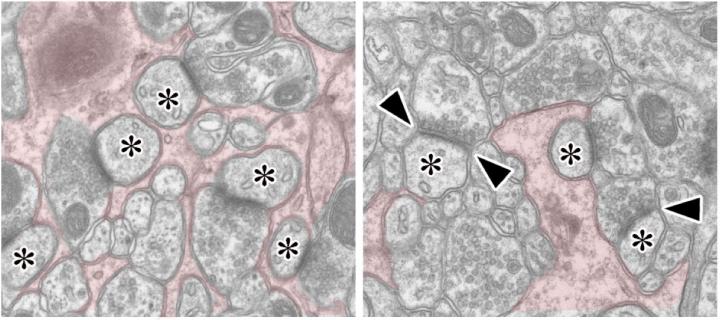A molecule for proper neural wiring in the cerebellum

In the normal mice (left panel), connections between Purkinje cells (asterisks) and climbing fibers or parallel fibers are thoroughly wrapped by Bergmann glia (colored in red), whereas they are exposed to their neighbors in the knockout mice lacking GLAST (right panel, arrowheads). Credit: Miyazaki T. et al., Proceedings of the National Academy of Sciences of the United States of America, June 27, 2017.
Researchers at Hokkaido University have found that the molecule “L-gutamate/L-aspartate transporter” (GLAST) plays an essential role in establishing and maintaining proper neural wiring of Purkinje cells in the cerebellum.
Purkinje cells are among the largest nerve cells in the brain. They are present in the cerebellum, a small structure in the back of the brain influencing motor coordination.
They are mainly hooked up to the nervous system by means of two distinct types of nerve fibers, “parallel fibers” and “climbing fibers.” Those fibers connect to different part of Purkinje cell dendrites, or the branches projecting from the cell body, segregating their territories.
GLAST is a molecule produced by specialized insulating cells, called Bergmann glia, that wrap around Purkinje cell synapses (a synapse is the structure connecting one nerve cell to another). GLAST's role is to remove excess glutamate, a neurotransmitter used by parallel and climbing fibers to send signals to Purkinje cells. This facilitates a “high-fidelity” signal, by allowing the right amount of glutamate to reach the targeted nerve cell without spilling over onto its neighbors. However, little is known about GLAST's role in the development of neural circuits.
Professor Masahiko Watanabe of Hokkaido University and his colleagues in Japan compared the wiring of Purkinje cells in normal mice and mutant mice lacking GLAST. The wiring of Purkinje cells in the mutant mice was laden with abnormalities.
Each Purkinje cell is normally innervated by a single climbing fiber as a result of competition between the fibers during development. However, in the mutant mice, Purkinje cells were innervated by multiple climbing fibers, which apparently caused the Purkinje cells to be atypically excited.
Parallel fibers were also affected. They robustly increased the number of connections with Purkinje cells, impairing the territorial segregation between climbing fibers and parallel fibers. Furthermore, in the knockout mice, Bergmann glial cells were improperly wrapped around the Purkinje cells, exposing them to the external environment.
In a different experiment, they also found that functional blockade of GLAST in normal adult mice results in similar abnormalities as seen in the knockout mice.
“We have shown that the glutamate transporter, GLAST, plays important roles in establishing and maintaining proper nerve wiring and insulation in the cerebellum. Further investigation should reveal how GLAST's function is related to the plasticity of the neural network,” says Masahiko Watanabe.
Media Contact
All latest news from the category: Life Sciences and Chemistry
Articles and reports from the Life Sciences and chemistry area deal with applied and basic research into modern biology, chemistry and human medicine.
Valuable information can be found on a range of life sciences fields including bacteriology, biochemistry, bionics, bioinformatics, biophysics, biotechnology, genetics, geobotany, human biology, marine biology, microbiology, molecular biology, cellular biology, zoology, bioinorganic chemistry, microchemistry and environmental chemistry.
Newest articles

Security vulnerability in browser interface
… allows computer access via graphics card. Researchers at Graz University of Technology were successful with three different side-channel attacks on graphics cards via the WebGPU browser interface. The attacks…

A closer look at mechanochemistry
Ferdi Schüth and his team at the Max Planck Institut für Kohlenforschung in Mülheim/Germany have been studying the phenomena of mechanochemistry for several years. But what actually happens at the…

Severe Vulnerabilities Discovered in Software to Protect Internet Routing
A research team from the National Research Center for Applied Cybersecurity ATHENE led by Prof. Dr. Haya Schulmann has uncovered 18 vulnerabilities in crucial software components of Resource Public Key…





















